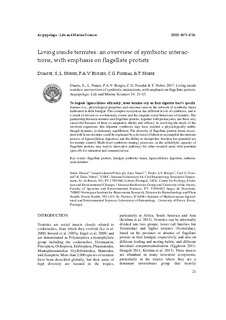| dc.contributor.author | Duarte, Sonia | |
| dc.contributor.author | Nunes, Lina | |
| dc.contributor.author | Borges, Paulo A.V. | |
| dc.contributor.author | Fossdal, Carl Gunnar | |
| dc.contributor.author | Nobre, Tânia | |
| dc.date.accessioned | 2017-08-25T08:16:34Z | |
| dc.date.available | 2017-08-25T08:16:34Z | |
| dc.date.created | 2017-05-03T12:59:34Z | |
| dc.date.issued | 2017 | |
| dc.identifier.citation | Duarte et. al (2017). Living inside termites: an overview of symbiotic interactions, with emphasis on flagellate protists. Arquipélago, Life and Marine Sciences 34, 21-43. | nb_NO |
| dc.identifier.issn | 0873-4704 | |
| dc.identifier.uri | http://hdl.handle.net/11250/2451825 | |
| dc.description | This journal provides immediate open access to its content on the principle that making research freely available to the public supports a greater global exchange of knowledge. | nb_NO |
| dc.description.abstract | To degrade lignocellulose efficiently, lower termites rely on their digestive tract’s specific features (i.e., hysiological properties and enzymes) and on the network of symbiotic fauna harboured in their hindgut. This complex ecosystem, has different levels of symbiosis, and is a result of diverse co-evolutionary events and the singular social behaviour of termites. The partnership between termites and flagellate protists, together with prokaryotes, has been very successful because of their co-adaptative ability and efficacy in resolving the needs of the involved organisms: this tripartite symbiosis may have reached a physiologically stable, though dynamic, evolutionary equilibrium. The diversity of flagellate protists fauna associated with lower termites could be explained by a division of labour to accomplish the intricate process of lignocellulose digestion, and the ability to disrupt this function has potential use for termite control. Multi-level symbiosis strategy processes, or the cellulolytic capacity of flagellate protists, may lead to innovative pathways for other research areas with potential spin-offs for industrial and commercial use. | nb_NO |
| dc.language.iso | eng | nb_NO |
| dc.title | Living inside termites: an overview of symbiotic interac-tions, with emphasis on flagellate protists | nb_NO |
| dc.type | Journal article | nb_NO |
| dc.type | Peer reviewed | nb_NO |
| dc.description.version | publishedVersion | nb_NO |
| dc.source.pagenumber | 21-43 | nb_NO |
| dc.source.volume | 34 | nb_NO |
| dc.source.journal | Arquipélago, Life and Marine Sciences | nb_NO |
| dc.identifier.cristin | 1467825 | |
| cristin.ispublished | true | |
| cristin.fulltext | original | |
